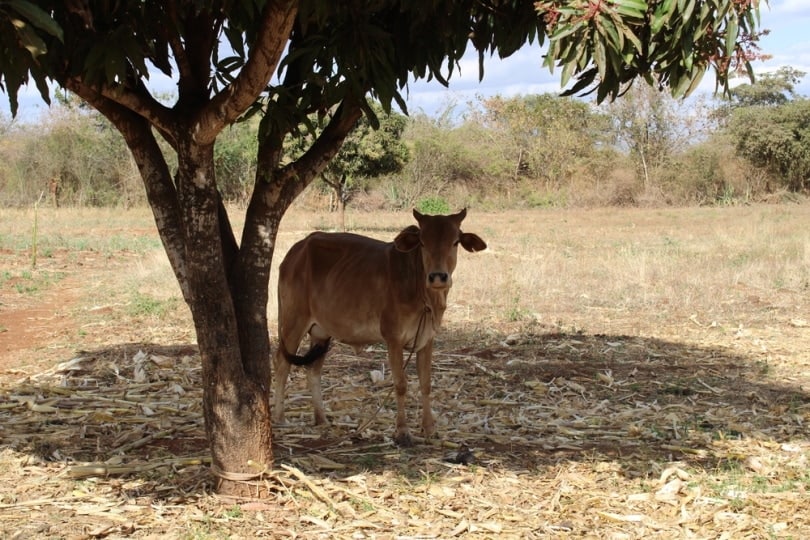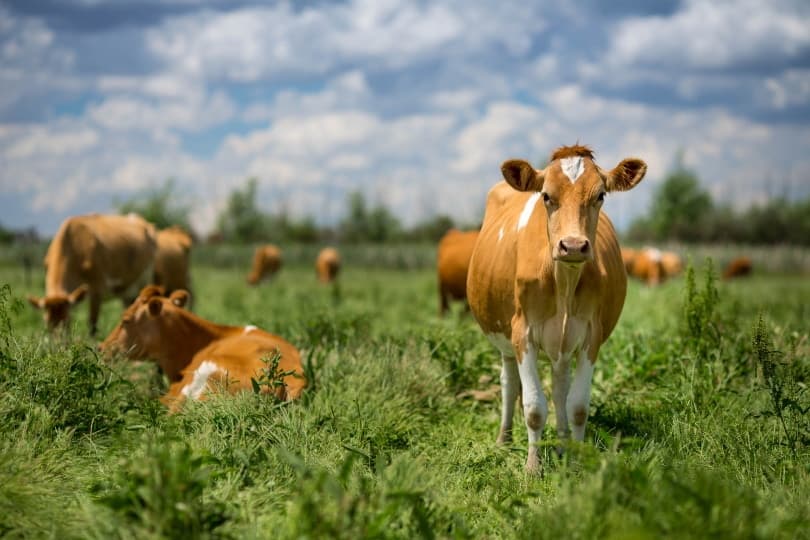Humans have a bond with the domestic cow that proves how valuable they are to people. Scientists theorize we owe our existence in the modern world to meat1. Think of how many products we get from these animals. After all, only about 60% is consumed. The rest makes a diverse range of products, from paint to shampoo to adhesives. How did this bovine go from wild animal to hamburger? Cattle domestication occurred in southwest Asia at about 900 BC.

Domestic Cow Origins
Genetics has helped scientists piece together the story of the domestic cow. This evidence suggests that our livestock are descendants of the now-extinct wild aurochs (Bos primigenius). Domestication occurred in southwest Asia at about 900 BC. This event coincided with the beginning of agriculture in the Fertile Cresent of the Middle East around the same time.
Interestingly, this period also marked the estimated domestication of cats. Agriculture attracted rodents and other pests, which felines, in turn, followed for an easy meal. It’s worth noting that agriculture made it possible for humans to settle down and form groups since food would now be more readily available than from a hunter-gatherer lifestyle.
Cattle moved from Asia into Europe during the Neolithic period, or about 10,000 years ago. They won’t reach the Americas until the late 1400s. Interestingly, there wasn’t much interbreeding prior to this time with the wild counterparts. Instead, the cattle reaching this part of the world were a product of up to 200 generations of natural selection, unlike the selective breeding of domesticated animals today.
That fact isn’t unusual. It took humans a while to make selective breeding a part of animal husbandry. It played out similarly with other domesticated animals, such as dogs, cats, and rabbits. Nevertheless, cattle, like other animals, evolved and adapted to their existence with humans. The tipping point was finding ways to make livestock and other species fulfill different purposes.

Genetic Pathway
Researchers have since provided a more complete picture of how cattle evolved from their Asian origins. A study by the University College London concluded that the domesticated cow is a descendant of as few as 80 animals humans raised in its early days based on paleogenetic evidence2. However, other findings point to other domestication events, particularly with another related species of the yak in central Asia.
Scientists have also uncovered data of possible domestication in the Indian subcontinent and another auroch species in Africa. What is certain is that the evidence points to the Bos primigenius as the ancestor of cattle in the Americas based on the lack of genetic diversity as the animals moved across the European continent. However, as scientists learned more, even the terminology evolved.
The cow we know today is the Bos taurus that came from Europe. The other animals from different domestication events are subspecies of this species. The word “cattle” is an old Anglo-French word meaning property. It was a fitting description for the time that applied to whatever a person owned. It wasn’t until the 16th century that the definition narrowed to mean just bulls and cows.
Today’s Cattle
The proposed domestication events meant that opportunities exist for selective breeding to serve various purposes. The over 450 breeds are classified into four categories: beef, dairy, dual-purpose, and draft animals. You’ll also find bovines that are better suited to specific climates for more straightforward livestock management. Others are associated with certain areas, like the Chianina of central Italy.
Agricultural scientists use genetics for more productive cattle, taking selective breeding to a new level. It’s better for the animals, the farmers raising them, and consumers looking for more nutritious and affordable meat. To say that cattle domestication has come a long way is a gross understatement. Today, there are an estimated 91.9 million animals in the United States alone, with 1 billion worldwide.
Beef provides an excellent source of protein, potassium, phosphorus, and vitamin B12, particularly with low-fat cuts. Despite efforts to disparage it, this protein source remains one of the most popular. Today, it’s nearly a $66 billion industry. That doesn’t include the byproducts and the economic value of livestock that have made cattle an integral part of the human experience.


Final Thoughts
Domesticated cattle are a ubiquitous part of our lives, even if we aren’t aware of all the ways we use them in everyday life. This move into animal husbandry was more than just having a readily available source of food. It also improved the health and lives of everyone touched by this industry. We can say the same about every animal humans have domesticated, including our dogs and cats.
Featured Image Credit: Vinai Suwanidcharoen, Shutterstock
